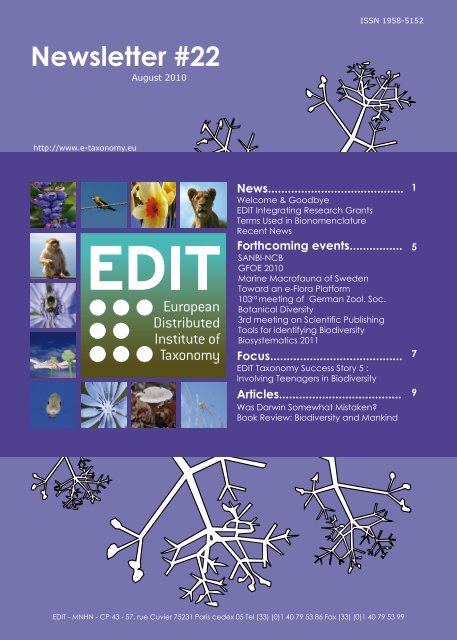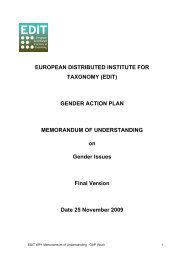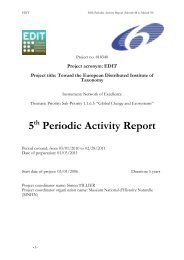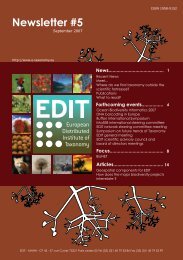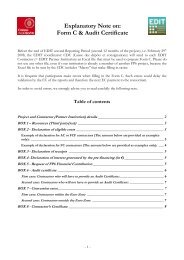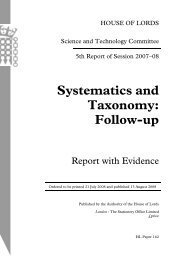High Resolution - EDIT | - European Distributed Institute of Taxonomy
High Resolution - EDIT | - European Distributed Institute of Taxonomy
High Resolution - EDIT | - European Distributed Institute of Taxonomy
- No tags were found...
Create successful ePaper yourself
Turn your PDF publications into a flip-book with our unique Google optimized e-Paper software.
ISSN 1958-5152Newsletter #22August 2010http://www.e-taxonomy.euNews......................................... 1Welcome & Goodbye<strong>EDIT</strong> Integrating Research GrantsTerms Used in BionomenclatureRecent NewsForthcoming events................SANBI-NCBGFOE 2010Marine Macr<strong>of</strong>auna <strong>of</strong> SwedenToward an e-Flora Platform103 rd meeting <strong>of</strong> German Zool. Soc.Botanical Diversity3rd meeting on Scientific PublishingTools for identifying BiodiversityBiosystematics 2011Focus........................................ 7<strong>EDIT</strong> <strong>Taxonomy</strong> Success Story 5 :Involving Teenagers in BiodiversityArticles..................................... 9Was Darwin Somewhat Mistaken?Book Review: Biodiversity and Mankind5<strong>EDIT</strong> - MNHN - CP 43 - 57, rue Cuvier 75231 Paris cedex 05 Tel (33) (0)1 40 79 53 86 Fax (33) (0)1 40 79 53 99
NEWSGoodbye & WelcomeDear reader, since the June issue,the <strong>EDIT</strong> Newsletter has changedits editor. Gaël Lancelot has movedon to a new position at the French NationalResearch Agency (Agence Nationale de laRecherche) after almost two years <strong>of</strong> gatheringand publishing news on meetings, workshopsand projects taking place within the network <strong>of</strong><strong>EDIT</strong> partner institutions, as well as informationon other projects related to <strong>EDIT</strong> and issues<strong>of</strong> general interest to taxonomists. Tasks GaëlLancelot performed to perfection, well suited ashe is with an educational background as MScin taxonomy and evolution, a PhD in history <strong>of</strong>science and a pr<strong>of</strong>essional career working asscientific resource manager for BioCASE andGBIF.At <strong>EDIT</strong> we are sad to see Gaël leave, hehas been a central figure taking care <strong>of</strong> bothexternal and internal communication in a verypolite and sympathetic, yet straight forwardand effective way. We therefore wish himthe best <strong>of</strong> luck in his new position and feelconfident that he will perform just as well forthe Agence Nationale de la Recherche as he didfor <strong>EDIT</strong>.Replacing Gaël is yours truly Jesper BirkedalSchmidt. I have formerly worked as scientificmanager for work package 2 <strong>EDIT</strong> partnernumber 3, based at the Natural History Museum<strong>of</strong> Denmark, University <strong>of</strong> Copenhagen. I am atrained biologist with an MSc in taxonomy andsystematics.I do not plan to change the face <strong>of</strong> thenewsletter, but will instead continue its currentlayout. The newsletter is well integrated in<strong>EDIT</strong>’s communicational routine and wellknown to our stakeholders. Furthermore, asthe <strong>EDIT</strong> contract with <strong>European</strong> Commisionends soon, there seems to be no point in fixinga new shape before the follow-up consortiumand activities are settled.I hope you will enjoy the current andforthcoming issues <strong>of</strong> the <strong>EDIT</strong> Newsletter,keeping you informed about <strong>EDIT</strong> workshopsand meetings, recent news from stakeholdersand sister projects as well as articles coveringnews from the <strong>EDIT</strong> partner institutionalactivities and topics <strong>of</strong> general interest fortaxonomists.Gaël LancelotJesper B. SchmidtNewsletter (<strong>European</strong> <strong>Distributed</strong> <strong>Institute</strong> <strong>of</strong> <strong>Taxonomy</strong>)Publisher: the <strong>European</strong> <strong>Distributed</strong> <strong>Institute</strong> <strong>of</strong> <strong>Taxonomy</strong>Publication Director: Mr. Bertrand-Pierre GaleyISSN: 1958-5152<strong>EDIT</strong> Newsletter #22 - August 20101
NEWS<strong>EDIT</strong> Integrating Research Grants- 2010 Awards<strong>EDIT</strong>’s IntegratingResearch Grantsis implementedto encourage increasedcollaboration betweentaxonomic researchers. Inparticular, <strong>EDIT</strong> wants todevelop collaborative descriptive/revisionarytaxonomy, which is in specific need <strong>of</strong> support.The third call for applications to theIntegrating Research Grants was announcedon April 21st 2010. In total 23 applicationswere received by the deadline (May 17, 2010).We are happy to publish below the list <strong>of</strong> sixsuccessful applicants, who were awarded thisyear’s grants.For more information on the IRG please visit:http://www.e-taxonomy.eu/irgSubjectPrincipalInvestigatorNumber <strong>of</strong>institutionsInstitutionsAmount(€)Revision <strong>of</strong> the Russulasect. Xerampelinae(Fungy, Basidiomycota)based on morphologicaland molecularcriteriaOld World, New WorldTanthoidea: a synthesis<strong>Taxonomy</strong> andphylogeny <strong>of</strong> theAmeiridae: a model forstudying oligomerizationand the transition frommarine to freshwaterhabitatsGeneric review <strong>of</strong>the velvet spiders(araneae: Eresidae) witha taxonomic revision<strong>of</strong> the African GenusGandanamenoTen species in one: thehidden biodiversity <strong>of</strong><strong>European</strong> mossesBuyck, Bart 4 Muséum Nationald’Histoire Naturelle (#2)Clark, Paul 5 Natural Historymuseum, London (#10)Huys, Rony 4 Natural Historymuseum, London (#10)Miller, Jeremy 4 NationaalNatuurhistorischMuseum – Naturalis(#7)Stech, Michael 5 Nationaal HerbariumNederland (#6)1420019815188621997014950Revising South-EastAsian MyrsinaceaeUtteridge,Timothy5 Royal Botanic Gardens,Kew (#11)106692<strong>EDIT</strong> Newsletter #22 - August 2010
NEWSUpdated Edition <strong>of</strong> Terms Used inBionomenclatureGBIF’s Informatics would like toannounce the publication <strong>of</strong> anupdated edition <strong>of</strong> Terms Used inBionomenclature, compiled by Pr<strong>of</strong>. DavidHawksworth. This is a glossary <strong>of</strong> over 2100terms used in biological nomenclature - thenaming <strong>of</strong> whole organisms <strong>of</strong> all kinds.The glossary is available in print-ready PDFformat as well as via an online web applicationthat can be browsed, searched, and output inHTML, JSON and RDF to support re-use andreferencing.GBIF is also producing a limited number<strong>of</strong> paper copies <strong>of</strong> the glossary which will beavailable at GBIF-supported meetings andevents. The web application supports thedevelopment <strong>of</strong> controlled vocabularies usingresolvable identifiers for nomenclatural terms.More information at:http://www.gbif.org/communications/resources/print-and-online-resources/bionomenclature/The web application is online at:http://bionomenclature-glossary.gbif.org/<strong>EDIT</strong> Newsletter #22 - August 20103
NEWSRecent NewsWhat is taxonomy:BioNET slide presentationBioNET slide presentation "Understandingthe world around you!" A collaborative effortfor the 2010 International Year <strong>of</strong> Biodiversityintroducing taxonomy to lay audiences,describing it's practice, uses and benefits forbiodiversity conservation and society.More information at:http://www.bionet-intl.org/opencms/opencms/index1.jspBISE (BiodiversityInformation System forEurope) is a new websitecentralising informationabout biodiversity in Europe.BISE is a partnershipbetween the <strong>European</strong> Commission (DGEnvironment, Joint Research Centre, Eurostat)and the <strong>European</strong> Environment Agency (EEA).More information at:http://biodiversity.europa.eu/EOL accepting applicationsfor 2011 Rubenstein FellowsThis international program supportbiodiversity research by graduate studentsand early career scientists. It provides partialsupport for up to one year to translatebiodiversity research and databases into onlineresources available through EoL.Applications deadline 15 Sep., 2010.More information at:http://www.eol.org/content/page/fellowsWhat is biodiversity:ONE stories from EEAThe 'Our Natural Europe' or 'ONE' stories arebeing developed by the <strong>European</strong> EnviromentAgency and its Eionet partners to illustrate ineveryday language what biodiversity is andhow we’re connected to it.More information at:http://www.eea.europa.eu/publications/one-finlandYam, Slug, Fish and SpiderFour <strong>EDIT</strong> partner institutionshave contributed to the Top 10New Species - 2010, a listannounced by the International<strong>Institute</strong> for Species Exploration(IISE) <strong>of</strong> spectacular organisms described in2009We would therefore like to congratulateAnnette Hladik and Claude Marcel Hladik <strong>of</strong>the Museum National d’Histoire Naturelle(partner #2) and Paul Wilkin and Odile Weber<strong>of</strong> the Royal Botanic Gardens Kew (partner#11) for the Udderly Weird Yam (Dioscoreaorangeana Wilkin), the Zoological Museum,Universiteit Van Amsterdam (partner #5) whostores three paratypes <strong>of</strong> the bug-eating slugAiteng ater Swennen and Buatip, 2009, RalfBritz and Lukas Rüber <strong>of</strong> the Natural HistoryMuseum, London (partner #10) for the FangedFish Danionella dracula Britz et al., 2009 andMatjaž Kuntner and Jonathan A. Coddington<strong>of</strong> the National Museum <strong>of</strong> Natural History,Smithsonian Institution (partner #27) for theüber orb-weaver Nephila komaci Kuntner andCoddington, 2009.More information at:http://species.asu.edu/Top104<strong>EDIT</strong> Newsletter #22 - August 2010
FORTHCOMING EVENTSSANBI - NCB InternationalWorkshop23-27 Aug, 2010, Cape TownSANBI and The Netherlands Centre forBiodiversity Naturalis arranges an internationalworkshop on the topic <strong>of</strong> «Using botanicaldiversity patterns to quantify current andfuture values <strong>of</strong> ecosystem services thatsupport human well-being in South Africa»The workshop is organized as part <strong>of</strong> theNWO WOTRO full application procedure.For additional information please contact:Shanelle Ribeiro (S.Ribeiro@sanbi.org.za)Niels Raes (raes@nhn.leidenuniv.nl)GFOE 40th Anniversary Meeting2010: The Future <strong>of</strong> Biodiversity- Genes, Species, Ecosystem30 Aug.- 3 Sep., 2010, GiessenThe next conference <strong>of</strong> the German Societyfor Ecology will be held at Justus-Liebig-University Giessen.Focus <strong>of</strong> this year’s meeting is The Future<strong>of</strong> Biodiversity - Genes, Species, Ecosystems.It will be relating to the following themes:(1) Learning from the past; (2) Uderstandingtoday’s world; (3) Exploring the future; (4)Applied biodiversity ;(5) Open topics.The organizers are looking forward to seeparticipants joining for discussions on thescientific knowledge <strong>of</strong> biodiversity.More information at:http://www.bayceer.uni-bayreuth.de/gfoe2010/First international workshopon the Marine Macr<strong>of</strong>auna <strong>of</strong>Sweden8–17, Sep., 2010, TjärnöA workshop aiming at students interested inthe systematics, taxonomy and morphology <strong>of</strong>marine invertebrates. It will provide anexcellent opportunity to meet experts onseveral <strong>of</strong> the major phyla.More information at:http://www.e-taxonomy.eufilesWorkshop_Tsjarno_2010.pdf<strong>EDIT</strong> International Workshop«Toward an e-Flora Platform»14-15 Sep., 2010, Brussels.At <strong>EDIT</strong> we are happy topresent this initiative <strong>of</strong> integrationbetween The National BotanicGarden <strong>of</strong> Belgium and theNetherlands Centre for BiodiversityNaturalis (section NHN), who are pleased toinvite you to the Edit International Workshop`Toward an e-Flora Platform´For additional information please contact:Thomas Janssen (thomas.janssen@br.fgov.be)Soraya Sierra (sierra@nhn.leidenuniv.nl)103rd annual meeting <strong>of</strong> theGerman Zoological Society17-20 Sep., 2010, HamburgThe Zoological <strong>Institute</strong> <strong>of</strong> the University <strong>of</strong>Hamburg host this year’s meeting.Focus will be on the themes: (1) The origin<strong>of</strong> biodiversity in the light <strong>of</strong> speciation andhybridisation; (2) The role <strong>of</strong> physiologicaladaptations and phenotypic plasticity; (3) Theinteractions between animals and plants.More information at:http://www.dzg2010.de/<strong>EDIT</strong> Newsletter #22 - August 20105
PPP Lösung für zweite GotthardröhreB,S,S.ZusammenfassungAuftragDer im Jahr 1980 in Betrieb genommene Gotthard-Strassentunnel muss saniertwerden. Die Sanierung verursacht längere Sperrungen des Tunnels. Eine Alternativeist, vor der Sanierung einen zweiten Tunnel zu bauen, der dann während derSanierungsphase des ersten Tunnels den Verkehr aufnehmen kann. Danach stündenzwei Tunnel zur Verfügung, die in Übereinstimmung mit der Bundesverfassungjeweils im einspurigen Richtungsverkehr genutzt werden können. Der zweiteTunnel erhöht die Sicherheit, würde das derzeit bestehende Tropfenzählersystemam Gotthard obsolet machen und zudem die Verkehrsbeeinträchtigungen bei Pannen,Unfällen und künftigen Instandhaltungsarbeiten deutlich reduzieren.Im vorliegenden Bericht wird die Frage geprüft, ob und unter welchen Rahmenbedingungenein zweiter Strassentunnel am Gotthard durch Private in einer PublicPrivate Partnership (PPP) finanziert, gebaut, betrieben und unterhalten werdenkönnte. Die Studie geht davon aus, dass eine private Gesellschaft· den zweiten Tunnel finanzieren und bauen,· die Sanierung des ersten Tunnels finanzieren und durchführen· und schlussendlich beide Tunnel betreiben und unterhalten würde.Die Studie beschränkt sich auf die Überprüfung der Machbarkeit einer PPP Lösungaus technischer und ökonomischer Sicht. Die Beurteilung der politischen Diskussionist nicht Teil des Mandats. Ausgewählte rechtliche Aspekte des PPP Projektesam Gotthard werden kurz dargestellt, jedoch keiner eigentlichen juristischen Beurteilungunterzogen.MethodikDer Bericht zeigt einerseits auf, durch welche technischen, vertraglichen und institutionellenLösungen PPP am Gotthard möglich wäre. Teilweise wird dabei Bezuggenommen auf vergleichbare Projekte im Ausland. Im Hinblick auf die finanzielleMachbarkeit beinhaltet der Bericht eine Modellierung von drei Varianten. AlleVarianten gehen von einer Vertragslaufzeit von 50 Jahren aus und sehen zur Wahrungder in den bilateralen Verträgen festgeschriebenen Mautobergrenzen für denSchwerverkehr eine Schattenmaut für LKWs vor. Die Varianten zeichnen sichdurch folgende differenzierende Charakteristika aus:6
FOCUSto pick up the litter themselves; they prefersanctions and education around the topic. Thepupils exchanged views about their needs aswell, and noticed that a good meeting point forteenagers to enjoy nature was missing.During visits at the Miramare marinereserve, the pupils were able to learn aboutand to see many different marine species (seepicture). They were also informed about theongoing research.One group <strong>of</strong> pupils within CLANFA decidedfor the pragmatic approach <strong>of</strong> actually pickingup the litter themselves (see picture). Thetreatment <strong>of</strong> litter from the <strong>of</strong>ficial side wasanother concern. The pupils decided to analysethe frequency and efficiency <strong>of</strong> the <strong>of</strong>ficial litterpick up with the Geographic Information System(see picture). The results will be presented toall schools <strong>of</strong> Trieste during the final exhibitionwhich will be held at the headquarters <strong>of</strong>the Coast Guard in the harbour <strong>of</strong> Trieste inSeptember 2010.The head <strong>of</strong> the education programme <strong>of</strong>the reserve, Dr. Milena Tempesta concludesthat the approach <strong>of</strong> giving much freedom, butscientific guidance to the pupils was successful.The teenagers appreciated particularly tohave been asked about their opinion andto be listened to. Since the pupils had manygood ideas for rather long termed projects,the Miramare marine reserve will continuethis activity. Several WWF partners in other<strong>European</strong> countries will now introduce similarprojects, based on the same approach, butadapted to the biodiversity and threats <strong>of</strong> theirregion.More information about the Marine MPAunder http://www.riservamarinamiramare.it/8<strong>EDIT</strong> Newsletter #22 - August 2010
ARTICLESRudy Jocqué (RMCA)Was Darwin somewhat mistaken?- Taxonomists have the floorDarwin (1859) accumulated animpressive amount <strong>of</strong> argumentsto support his theory on evolution.The quantity <strong>of</strong> data that has since beenadded to corroborate it, is overwhelming.It is therefore all the more surprising thatDarwin (1871) himself made an importantexception to his rules: sexual selection. Andsince no doubt could be cast on his genius,scores <strong>of</strong> scientists have wriggled to supportthe idea that is supposed to be <strong>of</strong>ten in clearcontrast with the principles <strong>of</strong> natural selectionitself. What is most remarkable is that themechanism <strong>of</strong> evolution by natural selectioncan be summarized in a few sentences whereasit needs pages to explain sexual selection.Reviews on sexual selection (e.g. Hosken &Stockley, 2004) are characterized by the manyincongruities among the data they summarizeand the confuse picture that results fromthem. Could it be that most <strong>of</strong> the researchin this field, focuses on the wrong targets andthat sexual selection is the side-effect <strong>of</strong> anunderlying phenomenon which has escapedattention? Or in other words, could it be thatwhat is called “sexual selection“ is simply amechanism that falls within the range <strong>of</strong> naturalselection? This would be in great contrast withthe many studies claiming that sexual selectionis a source <strong>of</strong> speciation in itself, independentfrom the ecological background in which itoccurs. This conflict <strong>of</strong> ideas is <strong>of</strong>ten by-passed.In the review referred to above, the conflict ismentioned in the acknowledgments!Since the field is dominated by ecologistsstudying one or a few species, the huge range<strong>of</strong> variation in the secondary sexual characters<strong>of</strong> some animal groups with stable somaticmorphology, is hardly taken into account.The phenomenon is demonstrated in manytaxonomic studies: e.g. genitalia <strong>of</strong> Dytiscidae,beetles (Jäch, 1993), Amaurobiidae, spiders(Wang, 2003), secondary se xual charactersin Erigoninae, spiders (Wiehle, 1960), sexualdimorphism in colour patterns <strong>of</strong> Cichlidae(Snoeks, 2004). But precisely the gradual range<strong>of</strong> complexity <strong>of</strong> genitalia or other secondarysexual characters, may help to understand thereasons for sexual selection or the underlyingmechanism.Fig. 1. Example <strong>of</strong> spectacular increase in thecomplexity <strong>of</strong> the aedeagus in nine species <strong>of</strong> thewater beetle genus Limnebius with somatically stablerepresentatives. Shown are the extremes at both ends<strong>of</strong> a long series comprising 82 species (after Jäch,1993).<strong>EDIT</strong> Newsletter #22 - August 20109
ARTICLESIn recent studies the importance <strong>of</strong> theecological background apparently begins todawn (see review by Cornwallis & Uller, 2010)and new hypotheses emerge. As a result <strong>of</strong> along term study on the cichlids <strong>of</strong> Lake Victoria,Seehausen (2009) for instance, recognizesthat male colour patterns might be markers forvariation in traits related to resource utilization,but eventually gives way to one <strong>of</strong> the classicsexual selection models known as “sensorydrive speciation”.However, the probability that there is agenetic link between behavioral patterns (<strong>of</strong>resource utilization) and secondary sexualcharacters, prepares for a landslide in thetheories about sexual selection and would atthe same time refute Darwin’s (1871) ideaabout the phenomenon. It opens a completelynew set <strong>of</strong> possibilities to explain a range <strong>of</strong>phenomena mainly observed by taxonomists:why do species with apparently identicalsomatic morphology have highly diversegenitalia ranging from very simple to verycomplex? Why are some groups <strong>of</strong> animalsprone to radiation and others not? Why dosmaller animals radiate more easily than largeones and why do the tiniest animals tend tohave the most complex secondary sexualcharacters? Why does speciation occur in sinksrather than in sources?The core <strong>of</strong> this new set <strong>of</strong> ideas inevitablyleads to the insight that there is a correlationbetween ecological specialization andcomplexity <strong>of</strong> secondary sexual characters.If they are corroborated, these ideas willdoubtlessly have far reaching consequences,but it is hard to fathom at this stage how deepthey will reach.ReferencesCornwallis C.K. & Uller T. 2010. Towards an evolutionary ecology<strong>of</strong> sexual traits. Trends Ecol. Evol. 25: 145-152.Darwin, C. 1859. On the origin <strong>of</strong> species by means <strong>of</strong> naturalselection. John Murray, London.Darwin, C. 1871. The descent <strong>of</strong> man, and selection in relation tosex. John Murray, London.Hosken D.J. and Stockley P. (2004) Sexual selection and genitalevolution. Trends Ecol. Evol. 19: 87-93Jäch, M.A. 1993.Taxonomic revision <strong>of</strong> the Palaearctic species <strong>of</strong>the genus Limnebius Leach, 1815 (Coleoptera: Hydraenidae).Koleopterol. Rundsch.63: 99-187.Seehausen, O. 2009. Progressive levels <strong>of</strong> trait divergence along aspeciation transect in the Lake Victoria fish Pundamilia, In Butlin,RK, J Bridle, and D Schluter (eds) Speciation and Patterns <strong>of</strong>Diversity. Cambridge, Cambridge University Press, 155-176.Snoeks, J. 2004. The cichlid diversity <strong>of</strong> Lake Malawi/Nyasa:identification, distribution and taxonomy. Cichlid Press.Wang, X. P. 2003. Species revision <strong>of</strong> the coelotine spidergenera Bifidocoelotes, Coronilla, Draconarius, Femoracoelotes,Leptocoelotes, Longicoelotes, Platocoelotes, Spiricoelotes,Tegecoelotes, and Tonsilla (Araneae: Amaurobiidae). Proc. Calif.Acad. Sci. 54: 499-662.Wiehle, H. 1960. Spinnentiere oder Arachnoidea (Araneae). XI.Micryphantidae-Zwergspinnen. Tierwelt Deutschlands 47: 1-620.Fig. 2. Examples <strong>of</strong> complexity increase in male palps,the copulatory organs <strong>of</strong> spiders. Examples <strong>of</strong> extremesin large groups <strong>of</strong> somatically similar species: Coelotes(after Wang, 20 03) and Diores (own observations).Arrows show direction <strong>of</strong> increase.10<strong>EDIT</strong> Newsletter #22 - August 2010
ARTICLESDr. Martin SharmanBook Review: Biodiversityand MankindFragile Web: what next for nature?Silvertown J. (Ed.) (2010) Natural HistoryMuseum, London, in association with the OpenUniversityThe biggest challenge that humanityhas ever faced, according to theintroduction to Fragile Web, is to find away for humans to prosper without endangeringbiodiversity. Not only is biodiversity beautifuland useful, not only is its destruction morallyquestionable, but human survival depends onproper stewardship <strong>of</strong> the life on our planet.This book develops these points, knittingtogether the threads that link humans withthe rest <strong>of</strong> the living world, and placing us andthe life around us in a historical, scientific andsociological context.The first thing that strikes the reader is thequality <strong>of</strong> production and <strong>of</strong> illustration. Everypage is illuminated by well-chosen graphs,drawings, paintings or photographs, some <strong>of</strong>which are works <strong>of</strong> art in their own right. Butas one delves into the text, it becomes quicklyclear that this is not, as it claims to be, thebiodiversity book for everybody.This is not a book a policy-maker mightread on the way to a meeting on biodiversitygovernance. Nor would you curl up on thes<strong>of</strong>a to read it unless you were seriouslyinterested in learning more about biodiversityand the importance to humans <strong>of</strong> its loss. Thisis a book written by scientists and sciencecommunicators for students <strong>of</strong> the context,evidence and consequences <strong>of</strong> the loss <strong>of</strong>biodiversity. And as a textbook, it does its jobpr<strong>of</strong>essionally and with competence.Fragile Web is well-structured andintelligent, and asks (almost!) all the rightquestions. Not only is it instructive, withevery page introducing new and interestinginformation, but in many thoughtful passagesit encourages readers to draw their ownconclusions, thus educating while it informs.The generally excellent captions allow thereader to understand the significance <strong>of</strong> theillustrations independently <strong>of</strong> the main text.The chapters follow each other easily, with aclever linking sentence at the end <strong>of</strong> each todraw the reader on to the next topic.The attractive first contact is somewhatmitigated by the evident multi-authorship,with some chapters written in a style thatis accessible and informative, and otherssomewhat dense and less engaging.Unfortunately, the first <strong>of</strong> these rather fact-<strong>EDIT</strong> Newsletter #22 - August 201011


